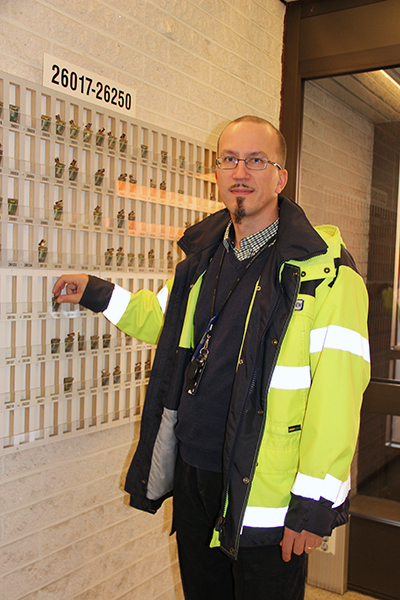Radiation is under close surveillance in Olkiluoto
The processes of a nuclear power plant generate radiation and radioactive substances. – We have to ensure the radiation safety both for our own personnel and the plant environment. The Radiation and Nuclear Safety Authority (STUK) oversees our operation closely, says Jarkko Laukkanen.
- We use radiation measurements, because we want to know the level of radiation at the plant, and because it provides a good means to monitor the operation of the process, continue Jarkko Laukkanen, who works as an instrumentation engineer in the I&C Department at TVO.
 |
| - Employees working at the plant carry with them their own personal TLD dosimeter. |
- Our main process, which is boiling water into steam using the thermal energy produced by nuclear reactions, also generates radiation and new radioactive substances as by-products. The fuel contains natural uranium and part of it is converted in the reactor into new substances. Some of these new substances are radioactive. The constant neutron flux in the reactor also makes some of the elements found in water radioactive, Mr. Laukkanen clarifies.
- There can also be a leak in the fuel, resulting in the release of radioactive fission gases. They are not condensed into water in the condenser like steam. That is why we have a system that collects residual gases from the primary circuit into a separate exhaust gas system. The radioactive gases generated in the main process and as a result of fuel leaks typically have quite a short half life. Their radioactivity can be decreased considerably by means of filters and by delaying them in the exhaust gas system for about 24 hours.
- When everything is working ok, radiation should remain on a stable and known level. If there is a change in the radiation level, there is also a reason for the change, and action is taken immediately to find that. We gather information about what has happened and how we can rectify the situation. Our objective is at all times to minimise any releases, explains Jarkko Laukkanen.
- The radiation measurements in use at the plant units make it possible to monitor the correct operation of the plant process and to verify that our plant is in good condition and safe, both to the staff and to the environment. There are more than 30 continuously operating radiation measurements at each of the plant units OL1 and OL2, and the OL3 unit will feature more than one hundred radiation measurements. The measurement results are presented on real-time in the control rooms of the plant units. Any alarms initiated by the measurements are also indicated immediately in the control rooms and the operators react to the alarms and initiate actions according to specific instructions.
- The data posted on STUK's website about releases from Olkiluoto and radiation doses in the environment near the plant show that the values have only been less than one percent of the permitted limit values, Mr. Laukkanen concludes with satisfaction.
Personnel radiation doses are low
- The personnel can also receive radiation doses when working at the plant. For this reason, the radiation risks have been identified in all the rooms and information signs that indicate the risks are provided on the doors of all the rooms. Where protection against radiation is necessary in a specific room, the room is usually kept locked, says Mr. Laukkanen.
- The risks are different during the annual outages. For example, pumps and valves, which may have accumulated radioactive contamination inside them, are disassembled for maintenance purposes. Protective equipment has to be used in such cases to prevent the contamination from gaining access in the employee's body or elsewhere within the plant facilities. Exposure to radiation during work is minimised e.g. by covering the radioactive object with lead sheets and by limiting working time in the area. For more demanding works, non-contaminated components are utilised for practice in advance to ensure that the actual repair work can be completed as quickly as possible. We also wear e.g. personal dosimeters when working at the plant to monitor risks related to radiation. All this has ensured that the radiation doses of the staff have remained reasonably low.
Radiation measurements also in surrounding areas
Radiation measurements are carried out also in the outdoor areas of the plant site and within a radius of ca. five kilometres in the surrounding area. There are almost 30 measurement stations of different types and this number will be increased, when OL3 is put into operation. In addition, STUK has its own measurement points.
- We want to ensure for our part the radiation safety of the plant personnel and the residents of the surrounding areas, Mr. Laukkanen stresses.
Waste is disposed onsite
TVO has in place various waste management systems for collection of radioactive waste generated at the plant units. Waste water is collected in tanks for filtration treatment.
- The different kinds of filters become contaminated. Used filters are either replaced or flushed, which produces radioactive waste. Solid waste is processed in a separate system, packed in waste barrels and transported to the final disposal facility for low and medium level operating waste.
After the highly radioactive spent fuel, is removed from the reactor, it is stored in the spent fuel pool in the reactor building for a few years. After that, it is transported to water pools in the interim storage facility for spent fuel to wait for its final disposal. The spent fuel is allowed to cool in the interim storage facility for about forty years more.
- When Posiva starts the final disposal operation in the 2020s, the first batches to be placed in the final disposal facility consist of fuel removed from the reactors of OL1 and OL2 at the turn of 1970s and 1980s. By then, the oldest spent fuel from Olkiluoto will have cooled enough to allow its final disposal based on the dry handling process.
Share